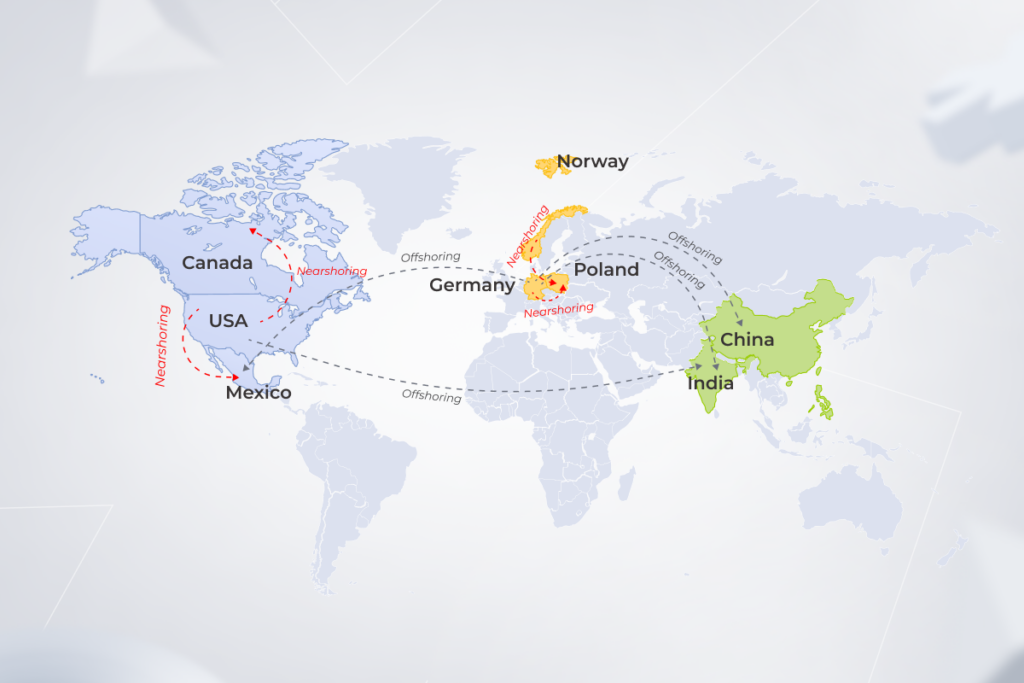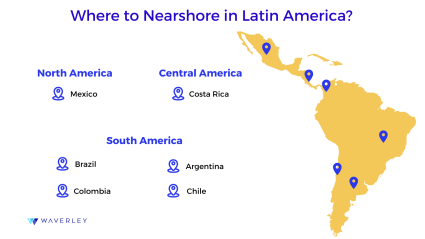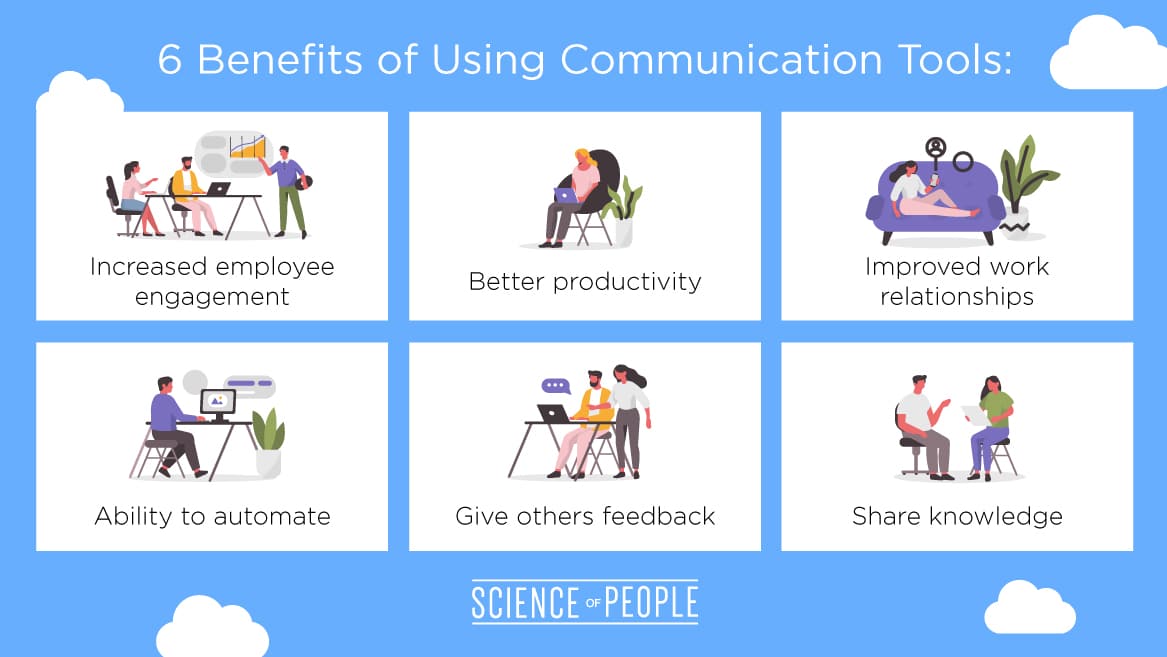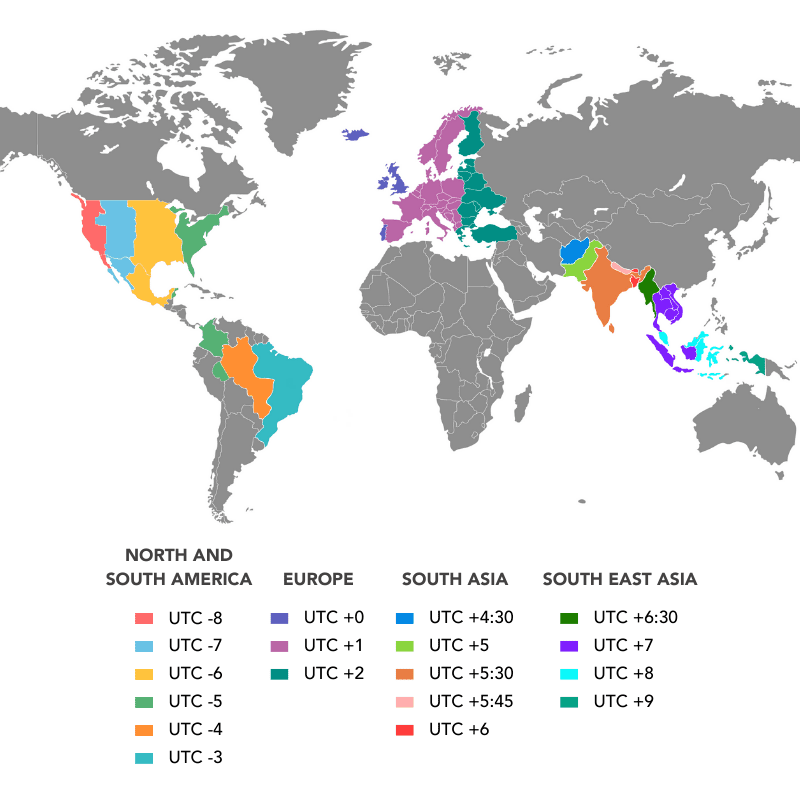Today’s tech landscape presents a critical challenge for companies: assembling a competent development team while managing costs effectively. Whether you’re a nimble startup or an established enterprise, the struggle to secure top-tier talent locally has become increasingly daunting.
Let’s explore the reality through concrete numbers. The demand-supply gap in the US tech sector is striking – companies require 162,000 new software developers annually, yet domestic universities produce merely 65,000 graduates. This imbalance creates an intensely competitive market, driving compensation packages to levels that many organizations find unsustainable.
Consider this: Latin America has emerged as a powerhouse solution, home to more than 1 million skilled developers. These professionals offer compelling advantages – aligned time zones with US operations, strong English proficiency, and cost savings of 40-60% compared to US-based talent.
However, here’s a key difference many organizations overlook: viewing nearshore development purely as a cost-reduction strategy often leads to disappointment. Long-term success demands strategic foresight and meticulous implementation.
Drawing from real-world scenarios of guiding over 50 companies in establishing thriving nearshore operations, this comprehensive guide delivers battle-tested insights. You’ll discover what drives success, what causes failure, and the strategic decisions that make all the difference.
This guide will break down:
– Strategic location selection tailored to your requirements
– Proven frameworks for remote developer recruitment and management
– Techniques for cultivating cross-border organizational unity
– Anticipated challenges and their strategic solutions
As demonstrated by current trends, the tech talent shortage will persist as a long-term challenge. However, with a well-crafted nearshore strategy, you can build a robust, expandable development capability while maintaining fiscal responsibility.
Step 1: Understanding What a Nearshore Tech Team Is
A nearshore tech team represents a strategic workforce positioned in a country geographically proximate to the client’s base of operations. This arrangement drives operational excellence through enhanced collaboration. The nearshore approach emerged as businesses sought alternatives to conventional outsourcing limitations. Consider this: the term “nearshore” fundamentally speaks to accessibility, where teams operate in complementary time zones, effectively dismantling traditional communication barriers.
As demonstrated by current market dynamics, the necessity for capable tech teams continues to surge. Traditional offshore arrangements frequently encountered obstacles like miscommunication and workflow disruptions due to time zone misalignment. Nearshoring addresses these challenges by ensuring synchronized operational hours. This strategic alignment proves instrumental for real-time decision-making, particularly in sectors where technological advancement moves at breakneck speed.
Let’s explore the global landscape: While Japan and China stand out as established offshore destinations with their technical prowess, countries like Mexico, Poland, or Portugal exemplify prime nearshore locations for US and Western European enterprises. Their strategic proximity enables synchronized workflows, fostering seamless project execution and management efficiency.

For readers seeking to delve into nearshoring drives innovation, examining regional specialization patterns offers valuable insights. “The Nearshore Evolution” by Sandra Hinkinson provides comprehensive perspective on this evolving landscape.
The Difference from Offshore and Onshore Teams
Picture this: three distinct operational approaches – nearshoring, offshoring, and onshoring – each offering unique value propositions for tech workforce management. While offshoring typically involves distant Asian markets, and onshoring maintains domestic operations, nearshoring strikes a strategic middle ground by leveraging neighboring nations.

The breakdown reveals compelling contrasts in cost-effectiveness and practicality. Offshore arrangements often prioritize cost reduction through distant labor markets, but face challenges in operational synchronization, cultural alignment, and travel logistics. Onshoring eliminates these barriers but commands premium costs due to domestic wage structures.
Nearshoring establishes a powerful equilibrium, accessing competitive labor rates while maintaining operational harmony. This approach sidesteps the complexities of managing teams separated by substantial time differences. Consider the natural cultural affinity between the US and Latin America – it streamlines communication and enhances collaborative success.
Have you ever thought about the distinctive advantages each model presents? For an in-depth analysis of these approaches, explore the Nearshore Model Breakdown.
Nearshore’s Strategic Advantages
The projected growth of nearshore tech teams stems from several compelling factors: optimized cost structures maintaining quality standards, streamlined communication channels, and accelerated project delivery timelines. Synchronized working hours ensure sustained project momentum, a critical factor in modern tech development.
Cultural resonance emerges as a powerful catalyst, minimizing misinterpretations and streamlining processes to forge cohesive team dynamics. Real-world scenarios demonstrate how reduced travel times for crucial face-to-face meetings enhance cost-effectiveness and operational efficiency.
Future trends indicate that nearshore strategies effectively support scalability and adaptability – essential elements in evolving tech landscapes. Organizations can dynamically adjust team composition without extensive logistical complications. This strategic flexibility empowers innovation, as highlighted by industry leaders implementing nearshore solutions.
Anticipated developments extend beyond immediate operational benefits. Strategic foresight reveals how organizations access diverse talent pools, securing specialized expertise not readily available domestically. By establishing nearshore tech teams, companies position themselves advantageously in an increasingly interconnected global market.
For those seeking deeper insights, case studies and comprehensive resources like “Hiring For The 21st Century Tech Model” offer valuable strategic perspectives.
Before we dive deeper into how to build a tech team with nearshore, it’s worth noting that this builds on some key principles of nearshore staffing. If you’re just getting started with nearshore staffing or want to refresh your understanding, our comprehensive guide on Nearshore Staffing will give you the groundwork you need. For those already familiar, let’s continue exploring how to build a tech team with nearshore…
Step 2: Nearshore Tech Team Benefits
Choosing the Right Nearshore Location
Let’s explore the essential criteria for identifying your ideal nearshore destination. Key regions like Latin America and Eastern Europe have emerged as strategic hubs, offering an advantageous blend of cost efficiency, time zone alignment, and technical prowess. For example, Mexico’s tech landscape continues to expand, driven by its geographical proximity to the US market and robust engineering education systems, as highlighted by Forbes. Picture this: Colombia’s burgeoning IT sector presents another compelling case study, combining competitive rates with growing technological capabilities.

Strategic foresight in location selection demands careful consideration of language capabilities, technical expertise, and regulatory frameworks. Have you ever thought about the impact of seamless communication? Countries like Poland and Argentina stand out with their exceptional English proficiency ratings. Real-world scenarios demonstrate how regulatory compliance shapes operational success, particularly regarding contractual obligations and data protection protocols.
[Action Items]:
- Analyze technical education standards and engineering capabilities across target nations
- Conduct comprehensive assessment of tech-related legal frameworks
- Review latest English proficiency rankings from EF Education First
[Dive Deeper]:
– Tips on How to Choose a Nearshore Partner in 2025
– Book: Global Teams: How the Best Teams Achieve High Performance by Jo Owen
Cost-Effective Nearshore Strategies
Long-term financial planning intersects with strategic advantages in successful nearshoring initiatives. As demonstrated by Deloitte’s analysis, nearshoring typically delivers 20-30% operational cost advantages compared to onshore alternatives. The key differences lie in maintaining excellence while optimizing resources. Future trends suggest combining fixed and variable cost structures for optimal financial management.

Projected growth requires balancing competitive compensation packages, infrastructure investments, and technological advancement. Consider this: while Brazil offers attractive cost structures, the advantages must align with robust infrastructure capabilities. Strategic foresight involves planning for scalability and anticipating market dynamics, including currency fluctuations.
[Action Items]:
- Develop comprehensive budget roadmap incorporating initial implementation and growth phases
- Analyze successful nearshore partnerships for actionable insights
- Create risk mitigation strategies for financial variables like currency dynamics
[Dive Deeper]:
– How Nearshore Talent Secretly Boosts Operations
This breakdown of nearshore advantages and implementation strategies provides organizations with a robust framework for optimizing their technical team deployment. The focus remains on developing sustainable, cost-efficient models without sacrificing quality standards.
Step 3: Building an Elite Nearshore Tech Team
Strategic Team Management
Mastering Digital Communication Tools
Let’s explore the essential communication infrastructure for your team’s success. Picture this: a seamlessly integrated ecosystem of video conferencing, instant messaging, and project tracking tools working in harmony. Consider platforms like Slack or Teams for real-time collaboration, complemented by robust project management solutions such as Asana or Trello to maintain crystal-clear visibility on deliverables and timelines.

Strategic foresight in scheduling is crucial. Establish consistent meeting rhythms that transcend time zones, fostering deeper connections through video interactions. For example, collaborative platforms like Google Workspace become your digital headquarters, enabling real-time document collaboration that breaks down geographical barriers and accelerates productivity.
Cultivating a Unified Company Culture
Have you ever thought about how culture shapes team performance? The key differences between successful and struggling teams often lie in cultural alignment. Start by highlighting your organization’s core principles and strategic vision. Create an environment where open dialogue flourishes naturally. As demonstrated by leading tech companies, celebrating wins – whether major releases or innovative solutions – strengthens team cohesion.
Real-world scenarios prove that investment in team connectivity pays dividends. Future trends point towards hybrid team-building activities, from virtual hackathons to cross-cultural exchange sessions, ensuring your nearshore team becomes an integral part of your company’s DNA.
Growth and Performance Optimization
Systematic Performance Assessment
Let’s delve into a comprehensive evaluation framework. Quarterly assessments provide the ideal balance for tracking anticipated developments while maintaining momentum. The breakdown should include both self-reflection and leadership insights, creating a 360-degree view of progress. Each review becomes a springboard for projected growth, aligning individual aspirations with organizational objectives.
Illustrated by successful case studies, effective feedback mechanisms might include pulse surveys and structured one-on-one sessions to gather valuable insights. The advantages of specific, actionable feedback become apparent in long-term team development. A comparison of feedback patterns reveals opportunities for strategic improvements.
Professional Development Excellence
In the coming years, continuous learning will be non-negotiable. Design a robust training ecosystem encompassing technical masterclasses, leadership development, and cross-cultural communication workshops. Leverage both internal expertise and premium learning platforms like LinkedIn Learning or Coursera for comprehensive skill enhancement.
The breakdown of professional growth should include personalized development paths. Supporting conference participation and certification pursuits creates concrete value for both individual and team capabilities. Knowledge-sharing initiatives, such as expert-led workshops, serve the dual purpose of skill elevation and team unification.
By implementing these strategic approaches, you’ll establish a high-performing tech team that excels in the nearshore model. To gain more insights on how to hire nearshore developers, you may want to read further on these practices.
Advanced Tips for Managing Nearshore Tech Teams
Proven Strategies for Optimal Team Performance
Cultivate Team Synergy Through Strategic Activities
Let’s explore how engagement transforms nearshore tech team dynamics. Picture this: team-building initiatives that transcend geographical boundaries can revolutionize team cohesion. While physical distance presents unique challenges, strategic virtual or in-person activities can bridge these gaps effectively. Consider this: implementing targeted workshops or cross-regional innovation projects can forge stronger connections. Future trends point to hybrid team-building approaches, such as virtual reality collaborative sessions or global innovation challenges.
For a deeper breakdown of team culture development, consider exploring The Culture Code by Daniel Coyle, which illustrates successful team dynamics. Additionally, Team Building by W. Gibb Dyer Jr. and Jeffrey H. Dyer offers strategic foresight into building high-performing multinational teams.
Establish Robust Knowledge Exchange Systems
Real-world scenarios demonstrate how systematic knowledge sharing accelerates innovation and team growth. As demonstrated by leading tech organizations, creating structured channels for cross-border information flow maximizes collective expertise. Strategic foresight suggests implementing digital knowledge hubs, expert-led masterclasses, and mentorship programs. These systems ensure long-term sustainability in team development and innovation.
Anticipated developments in knowledge sharing point toward AI-enhanced learning platforms and personalized development tracks. For comprehensive insights into knowledge management strategies, Leading Knowledge Management and Learning by Dede Bonner highlights the advantages of global team collaboration.
Strategic Solutions for Common Challenges
Navigate Cultural Nuances Effectively
Highlighting cultural diversity as a competitive advantage requires deliberate attention to communication patterns and workplace norms. Case studies show that successful teams actively embrace cultural differences through structured awareness programs and open dialogue. You may wonder about practical applications – regular cultural competency workshops and facilitated discussions can transform potential barriers into bridges for understanding.
The projected growth in global teams makes resources like The Culture Map by Erin Meyer invaluable for understanding cross-cultural dynamics in professional settings.
Implement Clear Performance Frameworks
Key differences in expectations can significantly impact project outcomes. Have you ever thought about how clear guidelines can transform team performance? A breakdown of objectives, deliverables, and timelines creates a solid foundation for success. Strategic foresight in establishing comprehensive performance metrics ensures alignment with organizational goals.
Real-world scenarios demonstrate the effectiveness of integrated project management approaches. For example, The Measure of a Leader provides concrete frameworks for performance assessment in distributed teams. The anticipated developments in team management tools offer new possibilities for tracking and enhancing team productivity.
Master Time Zone Coordination
The future trends in global team management emphasize strategic time zone integration. Advantages of modern scheduling tools like World Time Buddy showcase how technology can optimize team availability. Consider this: implementing flexible work arrangements and asynchronous communication methods can maximize productivity across time zones.

Projected growth in remote work necessitates innovative approaches to time management. For instance, establishing core collaboration hours while allowing for flexible schedules demonstrates respect for team members’ time zones. Long-term success in nearshore team management depends on creating sustainable practices that acknowledge and accommodate geographical differences.
Delving into these strategic approaches provides managers with comprehensive frameworks for elevating their nearshore tech teams’ effectiveness and cohesion.
Troubleshooting Common Issues
Strategic Solutions for Key Challenges
Mastering Time Zone Coordination
Picture this: Your teams spread across different time zones, yet working in perfect harmony. Let’s explore how adaptable scheduling makes this possible. Through strategic planning, teams can establish productive overlapping hours that benefit both sides of the partnership.

Here’s your strategic breakdown:
- Map Productive Hours: Leverage advanced scheduling tools like World Clock Meeting Planner to pinpoint optimal collaboration windows. Consider this your foundation for strategic planning.
- Implement Dynamic Schedules: Have you ever thought about core hours with flexible edges? For example, team members might choose to start at 7 AM or 10 AM while maintaining essential overlap periods.
- Strategic Meeting Framework: Establish recurring touchpoints during peak overlap hours. Real-world scenarios show weekly synchronization sessions dramatically improve project momentum.
- Digital Collaboration Suite: As demonstrated by successful teams, platforms like Slack or Teams become your 24/7 communication backbone. Configure smart alerts for critical updates across time zones.
- Future-Focused Communication: Projected growth in remote collaboration tools like Loom enables teams to share detailed updates regardless of time differences.
Navigating Legal and Contractual Frameworks
Long-term success in nearshoring partnerships depends on robust legal foundations. Let’s explore a comprehensive strategy:
- Strategic Contract Development: Craft agreements that outline anticipated developments in payment structures, deliverables, and jurisdictional considerations.
- Image Suggestion: Show a visual checklist of key contract points.
- Legal Excellence Network: Partner with specialized international legal experts who understand the key differences between jurisdictions and can navigate cross-border complexities.
- Structured Communication Protocols: Designate legal liaisons on both sides with deep expertise in international business relationships.
- Strategic Oversight: Case studies show quarterly contract reviews help teams adapt to evolving business landscapes and regulatory changes.
- Digital Documentation Strategy: Integrate advanced solutions like DocuSign for seamless contract management and modification tracking.
For strategic foresight into how to effectively implement nearshoring, explore our detailed guide.
Enhancing Team Alignment Through Systematic Check-ins
Highlighting the importance of clear communication, let’s explore proven strategies for maintaining team cohesion:
- Dynamic Daily Connections: Transform traditional stand-ups into focused 10-minute alignment sessions that drive real progress.
- Progress Tracking Framework: Implement robust project management tools like Trello or Asana for transparent milestone tracking. Explore more about finding nearshore developer talent.
- Strategic Feedback Loops: Develop channels that encourage proactive communication, enabling early issue identification and resolution.
- Cross-Cultural Integration: Foster an environment where cultural awareness becomes a competitive advantage in global collaboration.
- Team Cohesion Initiatives: Strategic investment in virtual team-building activities strengthens cross-border relationships and enhances project outcomes.
When systematic check-ins reveal opportunities for enhancement, consider elevating your project management approach to maximize team effectiveness.
Further Resources and Reading
Strategic Guides and Advanced Implementation
Future trends in team management demand a deeper understanding of specialized methodologies. Consider this: agile frameworks, while rooted in software development, have evolved into powerful tools for managing distributed tech teams. For example, “Scrum: The Art of Doing Twice the Work in Half the Time” by Jeff Sutherland illustrates strategic foresight in implementing these practices across geographical boundaries.
As demonstrated by industry leaders, learning from successful implementations proves invaluable. Case studies highlighting projected growth and anticipated developments provide concrete examples of triumph in the nearshore landscape. These strategic breakdowns showcase innovations in cross-cultural communication and project management, offering key differences that set successful teams apart.
Long-term Benefits of Nearshore Tech Teams
Strategic foresight in building nearshore tech teams extends far beyond cost considerations. Future trends indicate increasing market volatility, where the advantages of adaptable nearshore teams become paramount. These teams bring unique perspectives on regional markets and cultural nuances – crucial elements for navigating economic uncertainties and anticipated developments.
Have you ever thought about the power of diverse perspectives? Companies leveraging varied expertise and cultural backgrounds consistently demonstrate enhanced problem-solving capabilities. This strategic diversity drives innovation and creative solutions, illustrated by countless success stories. In the competitive tech landscape, such diversity isn’t just beneficial – it’s a strategic necessity.
Performance Metrics and Team Dynamics
Highlighting the effectiveness of nearshore tech teams requires sophisticated understanding of performance dynamics. Key differences emerge when examining works like “The Five Dysfunctions of a Team” by Patrick Lencioni, which explores the delicate equilibrium needed for sustained high performance. Real-world scenarios demonstrate how understanding these dynamics shapes productive environments.
Let’s explore performance metrics tailored specifically for distributed teams. While traditional measurements focus on output, strategic foresight suggests incorporating metrics for cross-cultural collaboration and innovation. This comprehensive approach ensures long-term success, focusing on both immediate results and projected growth potential.
Strategic Legal Framework
You may wonder about the complexities of international legal considerations. Breakdown of cross-border legal frameworks reveals crucial elements for success. Strategic partnerships with legal experts help navigate potential challenges. For example, comprehensive understanding of tax implications and employment regulations ensures seamless operation while avoiding costly setbacks.
Consider this: while “The General Theory of Employment, Interest, and Money” by John Maynard Keynes might seem distant, it provides fundamental insights into economic principles affecting international staffing. These principles guide strategic decision-making in establishing robust legal frameworks for nearshore operations.
Future-Focused Development
Anticipated developments in technology demand continuous learning initiatives. Strategic foresight in skill enhancement becomes crucial for nearshore teams facing future trends. Corporate training programs focusing on emerging technologies keep teams ahead of market demands. Resources like “The Ultimate Guide to Scaling Your Business with Nearshore Solutions” demonstrate the importance of strategic development in addressing specific nearshore challenges.
Long-term success relies on aligning individual growth with organizational objectives. These strategic initiatives foster an environment of continuous improvement and innovation. As demonstrated by industry leaders, this approach positions nearshore tech teams as pioneers in the evolving global market landscape.
Your Nearshore Roadmap for Future Success
Leveraging a nearshore tech team presents strategic advantages for companies focused on sustainable growth. Key differences in success factors include time zone compatibility, cultural affinity, and robust communication frameworks. As demonstrated by industry leaders, these foundational elements create the building blocks for high-performing teams.

Let’s explore the strategic foresight needed for implementation. Consider this breakdown: first, identify a location aligned with your organizational objectives. Then, prioritize relationship-building initiatives with team members. Real-world scenarios show that consistent check-ins and well-defined objectives strengthen team cohesion.
Long-term success with nearshore partnerships stems from full integration into your company’s ecosystem. Picture this: equal opportunities for professional development, training programs, and career advancement across all team members. Anticipated developments include proactive communication monitoring and swift resolution protocols.
Projected growth trends for 2024 highlight nearshore teams as integral to technological innovation. Companies mastering this approach gain competitive advantages through access to elite developer talent and accelerated scaling capabilities. The strategic roadmap begins with measured steps, embraces continuous learning, and evolves through data-driven refinements.
For example, your next strategic move might involve evaluating your existing team dynamics for nearshore integration opportunities. Through calculated planning and experienced leadership, you can forge a robust technical team that drives your company’s future achievements.